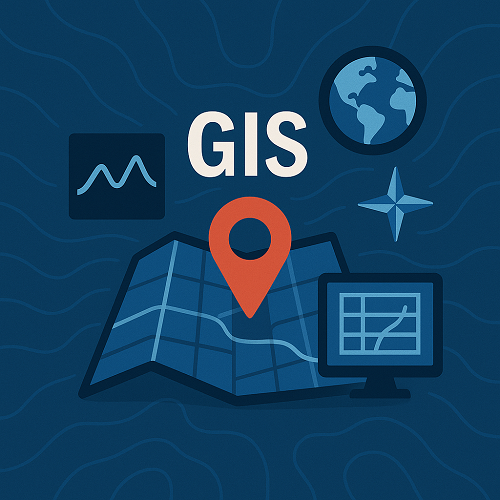- The global GIS sector in 2025 is driven by AI, IoT, and blockchain integration.
- Open geospatial data and interoperability standards are accelerating adoption.
- Soil and water resource management is a leading area of GIS deployment.
- Businesses benefit from more user-friendly and accessible GIS platforms.
- Blockchain boosts data integrity and trust in geospatial transactions.
- Cross-industry applications are expanding from agriculture to urban planning.
What’s new right now
The GIS industry is undergoing a rapid evolution. Integration with Artificial Intelligence (AI) and the Internet of Things (IoT) has enabled more precise and real-time geospatial insights for diverse sectors such as agriculture, utilities, and logistics. Advancements in open geospatial data initiatives are bringing free and standardized datasets to the public, driving innovative applications at scale. Meanwhile, blockchain applications are being piloted to secure geospatial records and ensure transaction transparency, as noted by GIM International. Soil and water management systems now use IoT sensors linked with GIS for optimized irrigation and conservation planning.
Why it matters
For business leaders, the new GIS capabilities translate into improved decision-making, reduced operational costs, and faster project deployment. Technologists benefit from seamless interoperability between systems, easier API integration, and scalable cloud deployments. With greater accessibility, even non-specialists can utilize GIS to interpret location-based trends and make informed choices. This democratization is vital for public agencies, small enterprises, and NGOs seeking cost-effective spatial analysis.
Key Trends Shaping GIS in 2025
Integration with AI and IoT
AI algorithms process massive spatial datasets, predicting patterns such as crop yield or traffic congestion. IoT devices feed live data streams into GIS platforms, enabling responsive operational adjustments. This combination results in richer, near real-time situational awareness.
Blockchain for Geospatial Integrity
By recording geospatial transactions on an immutable ledger, blockchain helps verify the authenticity of spatial data and land registries. This is particularly impactful in regions with disputed land ownership, where tamper-proof documentation is crucial.
Open Data and Interoperability
Government and research bodies are releasing open datasets in standardized formats, improving interoperability. This allows multiple GIS platforms to share and analyze data without format conversion bottlenecks, speeding up collaborative projects.
Comparing Emerging GIS Approaches
| Approach | Key Benefit | Primary Use Case |
|---|---|---|
| AI-Enhanced GIS | Predictive analytics and automation | Urban planning, precision agriculture |
| IoT-Integrated GIS | Real-time data sensing | Utility monitoring, disaster response |
| Blockchain-Secured GIS | Data integrity and trust | Land registry, critical asset management |
| Open Data GIS | Lower cost, faster access | Civic projects, academic research |
Case Study: Smart Irrigation Optimization
Problem: A regional farming cooperative faced water scarcity and needed to reduce wastage while maintaining crop yields.
Approach: The cooperative deployed soil moisture IoT sensors connected to a cloud-based GIS platform. AI models analyzed soil and climate data, generating optimized irrigation schedules. Blockchain was used to log water usage data for transparent reporting to regulators.
Outcome: Within a single growing season, water use dropped by 27%, and average yield increased by 8%, proving both environmental and economic benefits.
Implementation Checklist
- Define business goals and geospatial KPIs.
- Select a GIS platform with AI and IoT integration capabilities.
- Identify relevant open data sources for your project scope.
- Ensure interoperability with existing enterprise systems.
- Incorporate blockchain for data-sensitive transactions where appropriate.
- Deploy pilot projects and measure performance metrics.
- Train team members on GIS tools and data interpretation.
- Scale up and refine your systems based on feedback.
FAQs
Q1: What is the biggest driver of GIS innovation in 2025?
AI and IoT integration, offering real-time and predictive capabilities.
Q2: How is blockchain relevant to GIS?
It secures spatial data, making it verifiable and tamper-proof.
Q3: What is open geospatial data?
Publicly accessible spatial datasets, often in standard formats for easy use.
Q4: How can small businesses benefit from modern GIS?
Through cost-effective, user-friendly tools that support data-driven decisions.
Q5: Does interoperability require advanced technical expertise?
Newer systems reduce complexity, but some integration knowledge is still beneficial.
Q6: Which sectors are seeing the fastest GIS adoption?
Agriculture, utilities, logistics, environmental management, and urban planning.
Conclusion
The 2025 GIS landscape demonstrates a powerful synergy of AI, IoT, blockchain, and open data. These technologies are not only strengthening existing applications but also enabling new ones that were previously impractical. For organizations seeking to leverage spatial intelligence, now is the ideal time to assess opportunities and invest in modern solutions. To learn more about tailored implementations, explore our GIS services.
